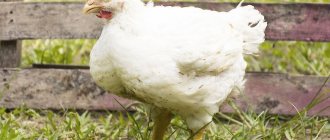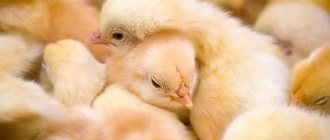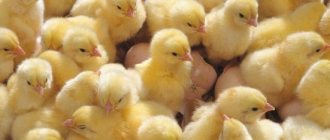First stage: how to place a hen on eggs
Arranging a home for a hen
To hatch the future chicken generation, you need a very good mother hen, which is worth its weight in gold for any farmer , since not every hen is able to take on the responsibility of hatching and raising small chickens. Not all chickens inherit this natural quality, although in some cases this maternal instinct can be awakened by artificial means, which can be quite effective. As a result, even a “frigid” hen can become a good hen. If a hen shows a desire to sit on the clutch and begins to cluck, it is necessary to provide her with a comfortable place to hatch her eggs.
To do this, you need to make a separate nest in a darkened area of the chicken coop. First of all, you need to knock down a box of the appropriate size. A cozy chicken house 70 by 70 cm is quite suitable, which should be placed away from perches and feeders. If you have several hens at once, then it is advisable to create a separate space for them from the rest of the chicken population, using various wooden partitions or chain-link mesh. Feeding hens and other procedures must also be carried out in isolation from the rest of the chicken family.
Laying eggs under the hen
First of all, you need to prepare fresh eggs .
For one hen, 12 eggs are enough, although it is advisable to place this number only under a large individual. Broiler chickens are not intended by nature to incubate future offspring; this breed of chicken was created for other purposes, so it is very problematic to make laying hens out of them. Only purebred egg-laying breeds are suitable for breeding, although meat chickens can also be made into laying hens. Before placing eggs under a laying hen, you need to make sure that they are fertilized. To do this, you can check them with an ovoscope or simply take clean and recently laid ones without various physical abnormalities. The main thing is not only to choose high-quality eggs , but also to properly stimulate the laying hen so that she sits on them. Whether the poultry will hatch its offspring or not, it all depends on your skills and abilities, which you must use in order to make a good hen out of a simple chicken.
The optimal period for starting incubation is usually considered to be the evening. Therefore, you need to place the hen in a pre-prepared nest after evening feeding, while covering the nest with a wicker basket.
Once a day it is necessary to release the hen for feeding. During the early stages of incubating eggs, the chicken should be fed only whole grains and given clean water to drink.
After four days, the basket can be removed, since the chicken is unlikely to get up from the eggs. During the incubation period, the hen tries to feed and drink very quickly, and then immediately hurries to the clutch.
Accidentally crushed eggs need to be promptly replaced, but such manipulations should only be done in the first few days.
After a week, the eggs can be checked using an ovoscope, but this must be done in the absence of the hen. Eggs that lack an embryo are immediately removed from the total mass.
On the twenty-first day from the moment they begin hatching, the chickens will begin to ask to come out and peck at the shell. But the hen is convenient because this process will take place under her strict control, unlike an incubator, where the poultry farmer himself must monitor and control the process of hatching and the birth of newborn chicks, observing the required temperature conditions.
Are you here
excerpts from the book by I. Gorbunova and L. Isachenko “Home Farm Month by Month”, prepared for publication
Experienced poultry farmers advise: before you start using an incubator, it would be nice to get the hang of hatching young animals under brood hens. They will tell you a lot and warn you about mistakes. You just need to be more attentive to their behavior.
For poultry farmers, the natural hatching of young animals gives special pleasure. It’s so interesting to watch the hen in the nest, her behavior, “conversations” with the brood, which is still sitting inside the egg. And how much joy there is when the babies hatch!
The females that have decided to become hens cluck as if they are telling their owners: “It’s time, it’s time, plant it.” A good black cherry has a calm character; it must be well-fed, because during incubation it loses a sixth of its weight.
Among the birds bred in poultry farms and ubiquitous in private farms, it is difficult to find a brood hen. More than other chickens, simple village chickens strive to incubate. Assiduous hens and turkeys. Under them you can raise not only turkey poults or chickens, but also goslings and ducklings. Even turkeys incubate. They are placed in a nest on egg linings, covered with a basket and left in a quiet place. After two days, the basket is removed, but the turkey no longer flies from the nest, and then eggs intended for hatching are placed under it.
The bird, still unknown as a hen, is first placed on test eggs. If she sits calmly, tightly in the nest and only comes out to walk, peck food and drink water, and remains in the nest at night, then you can safely lay eggs for hatching. The nest should be spacious: for a chicken - 40-50 cm in length, width and height, for turkeys, geese and ducks - more
Eggs intended for incubation are not left in nests; they are removed immediately after laying. In order not to erase the surface layer of the shell, take it carefully with clean fingers, and not with the whole hand. In the room where the hens are located, food and water are placed. Choughs themselves come out to peck, drink, and stretch their bones. But some people are so diligent that they don’t even look in the direction of the feeding trough. They are removed from the nest and forced to eat. Make sure that there is clean air in the brooding chamber, otherwise ammonia and other gases harmful to the embryo will penetrate through the pores of the shell.
The food is the same as before. However, it doesn’t hurt to watch the bird’s digestion. Is her droppings large but not runny? That means she's healthy. If it’s the other way around, then the owner needs to put thicker, crumbly mash in the feeder or replace it with grain for a while, preferably steamed oats.
From time to time, when black whales go off to eat food, they inspect the nests. It happens that an accidentally broken egg is found in one of them - it must be removed.
Different poultry have different incubation periods. A chicken breeds in 21 days, a turkey in 29, a duck in 28, and a goose in 30 days. However, these dates are not absolutely accurate. It happens that chickens hatch on the 19-20th day, but sometimes they are delayed, and the brood appears on the 23rd or 24th day. The fact is that chicks can hatch from newly laid eggs earlier than from lying eggs. Both the weather (cold and hot) and the zeal of the chough matter.
The general breeding rules for all types of poultry are approximately the same, but how to act in a specific situation? If a good hen appears on the farm, take care of her. Some poultry farmers band their best hen - attach a light wire to the leg so as not to accidentally kill it. Eggs are placed under it twice in the spring, and the chicken hatches them all. A box of hay is placed in a secluded place.
When eggs are selected for hatching, the date and month are written on them with a pen. If the same hen is planted a second time, then after the shell is removed from the nest, 11-13 eggs are laid again. The squeaks of the chicks from the previous brood should not reach her, otherwise they will not sit.
After the hatched chicks have dried, they are placed in a box and placed in a warm place. The last two or three chicks are allowed to dry under the feathers of the hen. Then she and her brood are transferred from the nest to the floor and all the babies are allowed to approach her. The hen immediately begins to teach them to peck, and they pick up small, small stones to grind food into their crops. The yolk reserve for a newborn chick is enough for two days, during which time it can do without feeding. If you immediately start feeding chopped eggs and something else, most of the chicks get diarrhea, and then, lo and behold, they die. When feeding on the second or third day, there is practically no waste at first.
Do chickens need a rooster to lay eggs? This question is sometimes asked by poultry farmers. Without a rooster, hens lay eggs anyway, and unfertilized eggs do not spoil so quickly and withstand transportation better, but with a rooster, egg laying is higher. Experiments have shown that pullets kept with roosters have heavier ovaries.
In April, you need to pay special attention to laying hens. The best of them lay eggs almost every day. Those that are worse - in a day or two, and the bad ones - after three days on the fourth. If you palpate the chickens in the morning, as soon as they fly off the roost, you can tell in advance whether a particular hen has an egg or not. Record the number of eggs obtained from each hen. In this way, the best chickens can be identified in three to four days. Some poultry farmers do not accept the technique of probing chickens; they believe that this creates a commotion - the laying hens are nervous. That is why they propose to study the external characteristics of the eggs from each hen (after collecting them from the nest, immediately write down which hens they came from), by which you can find out which bird the egg belongs to.
Some chickens lay a lot of eggs, but they are small. These laying hens should be mated with a rooster descended from a large-egg hen. In addition, pullets lay small eggs. Young animals are not bred from sick birds.
Turkeys, like geese, sit down to incubate, laying 11 to 17 eggs. However, geese of certain breeds, for example, Kuban, produce much more eggs. In ducks, egg laying lasts longer. Muskies produce from 20 to 80 eggs per season. It has been noticed that if the eggs laid by it are constantly taken from the nest of a laying bird, then it will lay more of them before incubation. However, musk ducks easily notice the loss and sometimes abandon their nest and fly somewhere outside the house. This also needs to be taken into account.
A female who wants to incubate can be identified by the following characteristics: she avoids the male and remains in the nest longer than others after laying the egg. Well, chickens, as you know, cluck.
Every day the hen strives more and more for the nest and finally stays in it for the night. This is where you need to lay eggs for hatching. She gets used to her new role more easily if she sits in the same place where she was rushing, especially if she has already bred offspring here. The hen will diligently sit on the eggs. Still, it is advisable to plant it in another, quieter place so that it is not disturbed by other birds. However, new difficulties arise here. In an unfamiliar place, the hen sometimes does not want to sit, she may drop her eggs and leave. This especially often happens with a bird that is accustomed to roaming freely. That is why, in order not to risk breeding eggs, they are planted with trial eggs.
If several hens are planted in the spring, then you need to provide a warm and dry room for them. An attic or barn would be good for this. In a cold room, incubation is less successful, because hatching usually begins in March, when the air temperature is not yet sufficient for the chicken or turkey to sit freely on the eggs.
In one of the corners of the “hen” compartment they make or place a ready-made nest, in another corner they fence off part of the floor with a board for sand and ash, in which the hen could bathe, and in the third they place dishes with water and food. The bottom of the nest is lined with some soft bedding, preferably soft hay. It is helpful to place a thin layer of soft feathers on top of this. The litter is laid so that a shallow hole is formed in the nest, where the eggs are laid.
As many eggs are placed under the hen as she can cover with her body and wings. For a chicken, this is 13-15 eggs, but if the hen is a large breed (Brahma, Cochin, etc.), they lay more - up to 17 eggs. When laying eggs, the air temperature is also taken into account. In cold weather, it is more difficult for the hen to heat a larger number of eggs, and the hatch may be worse. About 15 eggs are also placed under a duck, all the eggs that were laid by them before incubation are placed under a turkey and goose, and up to 38 eggs for chicken and duck eggs. According to poultry farmers, it is better to breed turkey poults under chickens, and not under the turkeys themselves. Chickens begin to cluck earlier and are more careful during incubation. Seven to nine turkey eggs are placed under each hen.
The success of incubation also depends on which eggs to choose for hatching. The main thing is that they must be fresh. The fresher the better. Those lying there for more than three weeks are considered unreliable. However, poultry farmers make exceptions to this rule. Before incubation begins, they keep the eggs in a dark place at a temperature of 5-15 degrees. Every day they turn the other side up. You can keep it in cardboard (store) packaging. In order not to touch the eggs with your hands and not to contaminate them with microbes, put a second package on top and tip it into it very carefully.
For the hen, single-caliber eggs are selected, of a regular, “egg” shape, with a completely clean shell, without calcareous growths, irregularities and cracks. Eggs that are too small, too round, pointed and too large are rejected. These most often turn out to be unfertilized or chicks with some abnormalities are hatched from them. For example, small eggs sometimes have a very small yolk, which is not enough for good nutrition of the chick.
There is a lot of talk among poultry farmers about the possibility of recognizing the fertilization of eggs. But most of these rumors are the fruit of unfounded imagination. The fertilization of an egg can only be determined under a microscope, but then it would have to be broken. However, the distinct outline of the puga is important when choosing eggs. The larger the space filled with air at the blunt end, the older the egg and vice versa. The distinctness of the puga indicates how uniform the density of the shell is.
Nests for birds of any kind must be arranged so that they are ventilated. To do this, they are placed on two boards. To create the necessary humidity, a piece of turf (harvested in the fall) or soft, clean rags is placed at the bottom of the nest under the bedding. During incubation, ducks love to bury themselves almost headlong into the litter, so their nest is generously lined with fluffy hay. It is better to place the hen in the nest in the evening. Then, according to poultry farmers, hatching will begin in the evening, which is more convenient for the owners than during the day when they are at work.
If the room is cold, it is advisable to heat it a little, that is, maintain normal room temperature. The room where the hens sit is often ventilated and cleaned daily. In this case, the hens are disturbed as little as possible, only the nests are inspected from time to time. Unintentionally broken eggs are removed, dirty litter is replaced with fresh one.
Source
Why does instinct appear?
The brooding instinct is natural for birds; it manifests itself to varying degrees in domestic chickens. For example, it is often completely absent in chickens, many generations of which have been raised in an incubator. But, nevertheless, nature sometimes takes its toll and even such hens have an instinct. This is also facilitated by the fact that the hen sees the eggs she has laid if she does not collect them from the nest for a long time. This is why it is important to remove the eggs from the nest every day. It is best to do this in the morning, since chickens lay eggs at this time of the day.
If there are a lot of chickens and the nest is visited by not just one individual, but several, you need to enter the poultry house and collect fresh eggs several times during the day so that the chickens do not see them. It is convenient for this purpose to use special nests with an inclined floor and an egg collector into which newly laid eggs will roll down. All that remains is to collect them at any appropriate time.
The hen instinct can also manifest itself if the bird comes into contact with a hen that has chicks, hears their squeaking, watches them run around the mother, this also increases its desire to incubate eggs.
It is easy to recognize a chicken that has decided to sit on eggs: in a short time it lays more eggs than usual, then egg laying stops; clucks a lot, often looks for secluded places where she could build a nest and sits there for a long time, plucking feathers and down on her chest. May lose appetite and have trouble eating. All this speaks of changes in her body caused by awakened instinct.
Fright in chickens
Out of fear, the entire flock of chickens can scream and cackle loudly for several minutes. Hearing a scream, the owner should carefully inspect the chicken coop and find out who or what scared the birds. If a chicken is grabbed by the wings or lifted above the ground, it screams loudly and protractedly.
Chickens' egg production is impaired due to fear and anxiety. Chickens must be carefully protected from stress.
The hen needs plenty of food and reliable protection
The chicken coop should be built in a warm and quiet place, reliably protected from noise and the entry of uninvited guests (thieves, wild animals, etc.).
The second one: how to put a hen on eggs
As mentioned above, not every chicken is capable of hatching future offspring. And this quality can be not only innate, but also acquired due to the fact that the owner of the poultry farm himself could often drive the bird away from the nest, thereby developing the corresponding instincts in it. Although chickens are quite flexible poultry, and if handled skillfully, they are able to restore their natural functions as a hen, even after a certain amount of stress.
The future hen does not require special training. The only condition for raising healthy chicken offspring is its proper feeding, which is as follows:
- Include crushed shells in powder form in your diet.
- Include food enriched with vitamins and minerals in your chicken menu, which can be purchased at specialized pet stores.
- Observe the correct feeding dosage for the required egg density, otherwise complications may occur when the chicks hatch.
As a hen, you need to choose only that hen that itself expresses a desire to hatch the laid eggs. Otherwise, you will have to raise the hen yourself or buy it ready-made, preferably from good friends. But for this you need to know that the future hen is ready to take on the responsibilities of a mother only after she reaches a certain age. For brood hens it should be at least one year.
A restless hen that clucks loudly and tries to quickly leave the nest when a person approaches is not suitable for hatching chicks. To determine the appropriate mother hen option, you must initially place pacifier eggs in the nest. After that, carefully observe the behavior of the chicken. If she practically did not leave the clutch for several days, then you will probably not make a mistake in choosing, giving her the role of a hen.
So, the future hen has proven herself to be the best, and now you can carefully replace the eggs with real ones, but it is advisable to do this at sunset, laying no more than fifteen eggs. But one should take into account the fact that if the hen notices a sloppy substitution, then the whole process can be written off as nothing, since she will simply stop caring for her future offspring, sensing something is wrong.
Initially, you need to identify and isolate a secluded place for the hen so that she is not disturbed by other relatives who can hatch her eggs, who may even peck at the future offspring in the absence of the mother. We should also not forget about the constant change of water, which should always be near the nest.
Ash and sand baths are as necessary as water. To take such baths, you need to fill a shallow basin with the above components in equal proportions and place it on the floor. With proper care of the hen, the appearance of chicks will not take long and they will make their first sounds after just a few weeks of hatching.
Why is it worth imprisoning by force?
You can wait for the natural desire to become a hen and bring offspring. But there are many difficulties here, since a hen can only start clucking in the middle or end of summer, while she has collected the required number of eggs in the nest for planting. Raising these chickens is a little more difficult.
Why do chickens peck their eggs (what to do)
Any representative of the chicken coop can start clucking. But if the bird is thin and weak, it may not be able to cope with the task. Experienced owners recommend choosing a hen yourself; it is best to take an experienced bird that has already coped with a similar task.
You should also thoroughly prepare the bird for its responsible mission: about a couple of weeks in advance, start actively feeding it so that it accumulates more fat and nutrients.
Important! Before forcibly placing a chicken, you should take into account that she needs a comfortable place to hatch her chicks. The nest should be located in a secluded dark place, a remote corner of the chicken coop. For example, this could be a box of straw or a basket in which the bird will not be disturbed.
Another advantage of portable planting is the ability to control the number of eggs in the clutch, as well as their quality. After all, chickens can collect eggs in their nest for a very long time, and chicks will not hatch from them. When laying the selected bird yourself, you can secretly add eggs and choose the best and freshest ones for laying.
Nest preparation
No human assistance required
There is no need to carry out any manipulations with the hen. She knows what she's doing. Human intervention can discourage her, frighten her and provoke her to leave the nest. So if you want her to sit, leave her completely alone. Fertilized eggs can only be checked by candling when the chicken has left the nest to eat and drink.
There are cases of joint hatching and raising chickens. This is when one hen hatches chicks in a spacious nest, and the second sits nearby. Although there may be only one egg under the second one. This is fine. Place more eggs under the second one.
But here it is important to make sure that the second hen is hatching the chicks, and not just sitting for hours and bothering the first. If they both don't leave their clutches, leave them, they'll figure it out on their own.
But if the second one can leave the clutch for an hour or two, then this is no longer a hen. In this case, we relocate the hen.
And we give the second chicken complete freedom. Let her do what she pleases. Maybe she is “maturing”, her hormones will surge and she will responsibly “serve her time” and raise the kids.
How long does it take to hatch chicks: timing
The incubation process lasts three weeks. Chicks begin to hatch 19-21 days after the hen lays the clutch. During this time, it is necessary to carry out 3 examinations using an ovoscope. This device allows you to identify abnormalities in embryonic development. The examination is carried out on the 7th, 11th and 18th day from the start of incubation.
- During the first examination, normally the embryo should not be visible, only its shadow and blood vessels on the yolk. If development is poor, the embryo is visible near the shell. Dead embryos have dark vessels in the form of a ring. Completely light colored eggs are due to a lack of fertilization.
- A second examination of healthy fetuses shows a network of blood vessels on bright field. Their shadow makes up a quarter of the egg.
- On the third examination, the embryo is visible as a dark spot. You can also observe its movement at the blunt end of the egg.
All defective specimens must be removed from the clutch, and the remaining ones must be placed closer to the center of the nest.
Table by day - how long eggs hatch
Method 1. Use old-fashioned methods
Many chicken coop keepers believe that for a bird whose instincts have awakened, it is necessary to expose it to stressful conditions. Then she will forget about her maternal feelings and after a while she will begin laying eggs again. Let's look at some methods that are often used in rural farms.
- Rinse the chicken with cold water. The kvochka is completely doused or dipped in a basin of cold water. The fact is that the bird’s body temperature rises during the incubation period: this way it ensures the optimal temperature for the maturation of future offspring. To prevent chickens from sitting on eggs, people lower their body temperature with cold water.
- Deprive her of food. Some poultry farmers believe that a hunger strike helps discourage the desire to brood. The chicken is not given food for several days, after which it, being in a state of shock, stops clucking.
- Put him in prison. The chicken is placed in the basement for several periods to deprive it of a comfortable habitat. As you know, chickens love light, so the room should be dark. At night, chickens are less active, which will allow them to forget about their awakened instincts. The quonka is also fed in the dark.
All these methods, despite their popularity among the people, are not very effective. They help some, but for others, all tough attempts to dislodge the hen from nesting end in failure: the hen, after several days of torment, returns to incubation. Sometimes the method works against the owner: the chicken not only stops hatching, but also stops laying eggs for a long time.
In addition, these methods are very cruel to a living being, and can even lead to dire consequences. For example, dousing a bird with ice water can cause respiratory tract disease. And prolonged starvation and keeping in the basement can not only weaken the chicken’s body, but also lead to death.
As a result, using cruel and irrational methods, you can destroy your laying hens. Therefore, such techniques should be treated with great caution. Even if your neighbor claims that going on a hunger strike helped him keep the chickens away from the nest, it won't necessarily work in your case. To discourage hens from incubating, modern poultry farming uses more gentle methods. We'll talk about them further.
Choosing a brood hen
Not every hen is suitable for brooding. Some birds have a weakened maternal instinct or do not have it at all. They are absolutely not suitable for such purposes, since they can leave the nest or chicks at any moment. Conventionally, all chicken breeds can be divided into three categories:
- Birds with a well-developed instinct for brooding. They complete assigned tasks without any problems and take good care of their offspring.
- A bird with weakened maternal instinct . Initially they sit well on the masonry, but can leave it at any time.
- A bird without maternal instinct . Such chickens show absolutely no interest in breeding chickens. Usually these are crosses and hybrids of an industrial type, as well as some breeds.
Ukheiliyu chickens are recognized as the best hens.
Even breeds renowned for high maternal instinct may have individual birds without it. Hens for laying should be selected according to individual characteristics and personal observations.
Hen body temperature
The normal temperature of a chicken during brooding first decreases and then increases. In the first week - +38-39°C, in the last week it rises to +40°C. The temperature in the nest varies between +33.4 - +38.8°C. If a bird leaves the clutch for a long period of time, the eggs may become cold, which will affect the quality of the brood. In the second stage of incubation, the eggs produce heat on their own, so the chicken often does not sit on them, but stands in the nest above the clutch.
The hens periodically turn the eggs using their beak and paws. This allows you to equalize the temperature difference in their upper and lower parts.
Kvochki: how to determine the best breeds
According to widespread observations, the best ones for hatching are the most common mongrel chickens. This is explained by a strong natural instinct to breed offspring, which they have not yet lost, as well as by their body mass, which allows them to close their eggs. Among productive breeds, meat and egg-producing birds most often lay eggs. If you choose by breed, then the best are considered to be Kuchinsky Jubilee, Cochin, Brama, Welsumer. You can identify a future hen by the following signs:
- frequent clucking;
- long stay in the nest;
- decreased egg production;
- fluffing feathers to increase body volume;
- plucking down and lining the nest with it.
It is important to understand that some of these signs may also indicate health problems in the bird.
Recognizing a hen in a hen - looking for signs of a hen
There are a number of signs by which you can recognize a hen in a hen:
- 1. Often during the spring egg-laying period, a hen has a desire to hatch eggs.
- 2. If a bird sits regularly and for a long time in its nest, clucks, creates comfort in its nest by plucking and lining its feathers, and rarely goes out to feed, then this means that you have a real mother hen.
- 3. Another sign in chickens is a reduction in the comb and a change in its color to pale pink.
- 4. Some birds, when hatching eggs and raising chicks, begin to show aggression towards humans - this is how they protect their nest and offspring.
- 5. The hen makes her nest in a secluded place. More often this may be the far corner of the chicken coop.
- 6. Sometimes hens that are ready to hatch eggs lose interest in food, so it is necessary to force them to eat periodically, otherwise they will quickly lose weight.
An old chicken should be placed on eggs: it hatches better than a young one, but you should not replace its nest, otherwise the chicken may refuse to sit on the eggs. If there are few eggs under the hen and they are visible, it means she has poor hatching abilities. And if there are a lot of them, then it’s worth removing a few so that the bird completely covers all future chickens.
This is interesting: How to determine the age of a chicken - the age of laying hens
2 Ways to make a chicken a hen
It is possible to plant a domestic chicken on eggs yourself, following a number of recommendations. For novice poultry farmers, there are a number of tips shared by experienced specialists:
- you need to prepare the nest in a quiet and comfortable place;
- It is better to plant a chicken on eggs in the evening, or light should not enter the chicken coop when planting a hen;
- the nest should not be too large, about 54 by 34 cm, otherwise the eggs may roll out;
- You can use a wooden box, be sure to insulate it from the inside with straw. Over time, the hen herself will do everything in the nest as she needs;
- it is permissible to test the brooding instinct by placing decoy eggs on eggs; after 2-3 days they are replaced with real ones, carefully placing the eggs under the tail so that the bird does not notice the substitution;
- to stimulate brooding, you can leave about 10 eggs in the nest;
- You can also put the bird in the nest, cover it with a basket on top, open it after 3-4 days and observe: if the bird remains sitting, then you need to put eggs on it
- The best hens are meat and all-purpose chickens.
Hatching process
It is interesting to observe the unique process of the birth of babies. One can only marvel at the wisdom of nature, because caring for a mother hen’s chicks begins from the first days of incubation. The chicken accustoms the babies to the sounds of its voice and listens carefully to what is happening. She hears the first squeak, rolls the eggs that have begun to cool deeper under her, and helps make the first pricks on the weak chicks when they are born:
- 2-3 days before the chicks hatch, even a person can hear a soft squeak coming from under the shell. The chicken listens carefully to the sounds, clucks over each egg, and moves some.
- 1 day before the babies are born, the first cracks in the shell appear: the grown chicken tries to break through the hard shell with an egg tooth (a hard growth that falls off 2-3 days after the chick emerges).
- The cracks are increasing, a clear squeak and a soft knock of the beak on the shell are heard.
- 3-4 hours before pecking, a hole appears in the shell through which the beak can be seen.
- The hole quickly increases in size, and soon the head and legs with claws may emerge into it.
- Having completely destroyed the protective layer, the baby finds himself in the nest next to his mother, completely wet, and the hen gently pushes him under her.
This happens with almost every egg. Watching carefully, the chicken only sometimes helps weakened babies who cannot break the shell on their own
She may gently tap the shell several times or just once to help.
Having warmed and dried the chicks, the mother will show the little yellow lumps how to eat, drink, and where to look for food. This will not happen until the chicken is ready to move. There is no need to speed up this process either.
Arrangement of the nest
The nest in which the hen will hatch her chicks must be prepared in advance. And after the bird has already settled on it, it will gradually independently make the place more cozy and comfortable. You can use a cardboard box, a wooden box, or a shallow basket as a container for the nest.
Raise the corners of the container to prevent eggs from rolling out from under the bird. And in front of the nest, hang a canopy made of light fabric to create maximum privacy and a calm environment for the bird. The canopy should not interfere with the bird’s access to the “house”.
The nest should be located in a secluded and dark place on a small hill so that small rodents cannot reach the eggs.
As for size, the chicken should be located comfortably and freely in the nest. However, there is no need for a nest that is too spacious—the eggs may roll out of it. The optimal parameters are 55x35 cm.
Inside it is necessary to form a soft bedding in the shape of a concave cup from bird fluff and dry straw. Eggs are placed in the recess of the cup. It is also necessary to treat the litter with a special compound that protects against parasites; ash or naphthalene scattered along the bottom of the nest will also work.
Make sure that the air temperature in the chicken coop when incubating eggs does not fall below +20 degrees. Humidity must be maintained at 70-78%.
Chicken landing
It is not difficult to plant a chicken on eggs at home; all you need to do is follow a few simple steps. First of all, it is important to properly organize the nest. It should be in a fairly quiet place, the bird should be comfortable in it. But at the same time, it should not be too spacious so that the eggs do not roll out during incubation. The ideal size is 55 by 35 cm.
To do this, you can use a wooden box in which straw is placed. In the future, the chicken will create comfortable conditions for brooding and insulate the area with down and feathers. It is best to cover the exit with something light so that the chicken can leave and enter the nest at any time. Then they put in the decoys - it is necessary for the chicken to get used to incubation. After a few days, the decoys are replaced with real eggs.
It is important to know that if there are several hens in one chicken coop, they should be seated as far apart as possible. This should be done in order to eliminate confusion among the birds, which could lead to possible fights. After the hen is placed, she will be able to clean up the nest herself; the poultry farmer will only need to periodically monitor it while the hen is feeding.
Selection and placement of eggs
The selected bird is taken to the nest, and if everything goes well, it begins to hatch the eggs. One of the most important points in raising chickens is the correct placement of eggs. It is important to know which ones to choose for incubation. Only fresh eggs, laid no earlier than six days before laying, are suitable; they should not be broken or dirty. It is better to take medium-sized specimens, because small ones often have an inferior embryo, while large ones can contain two embryos.
It is important to correctly determine the required number of eggs to lay - it directly depends on the build of a particular bird. The quantity must be selected in such a way that the chicken covers them all, provided that they are located in one layer. If the chicken is large enough, then add 13 to 15 pieces.
During the hatching period, you cannot add more eggs, because after the first chicks appear, the hen will leave the nest. It is worth paying attention to the fact that the chicken copes very well with hatching eggs and other birds.
Advantages and disadvantages of breeding chickens with whooping hens
Hatching eggs by a brood hen is an ideal way to raise poultry. Main advantages:
- The owner does not need to supervise the process, turn the eggs, or control the temperature.
- Kvochka, a hen who likes to incubate eggs, will take care of the chickens herself. She will teach the chicks to drink, eat, and protect them from threats and bad weather.
- Instinct will tell the hen how to keep her babies warm. She will help them hatch, break the shell if necessary.
- The hen will roll out the non-viable eggs from the nest.
- There is no need to spend money on buying an incubator.
Hen and chicks
Pay attention! When sitting in the nest, at first the hen does not distinguish lifeless eggs from those in which embryos develop. It sits on everything and does not allow other chickens to approach its favorite place.
There are reasons why owners breed birds in an incubator:
- A quonka can sit on one and a half dozen eggs, no more, so that all are covered with feathers. A larger quantity can be placed in the incubator.
- The eggs are collected in advance, and the hen must be placed in the nest at the same time.
- Sometimes quons inadvertently crush eggs and chicks.
- The future brood needs to have a separate walking area fenced off, as the hens become belligerent towards anyone who approaches.
Considering the pros and cons of raising chicks naturally, it becomes clear that it is easier for the owner of a small chicken coop to use a hen to hatch chicks. On large farms, it is more convenient to breed poultry in an incubator.
How to choose a hen?
If there is a need for a live incubator, the first step is to find a hen suitable for this purpose. It is necessary to observe for some time the available population of birds suitable for incubation and select those that are most suitable.
A chicken with an awakened maternal instinct has behavior that differs from other individuals:
- she tries to sit in the nest for a long time, reluctantly leaving it;
- the bird clucks anxiously;
- the hen will also pluck her feathers to make a nest.
In addition, according to farmers, the best hens are birds aged two to four years. And the comb of a bird, ready for incubation, changes slightly in color, becoming pale pink.
The appetite of such an individual decreases, so sometimes the future hen has to be fed almost by force: otherwise the bird can lose a lot of weight.
A hen can be identified by the following feature: the bird looks for the most secluded and dark corners of the chicken coop, sitting in boxes, baskets, and other suitable places. The signs listed above make it possible to accurately select a hen.
The presence or absence of maternal instinct largely depends on the breed of chicken. Bantam and silk breed chickens are particularly prone to breeding offspring. These birds are able to hatch with equal zeal not only their own eggs, but also those of others.
Also, representatives of the following breeds are naturally good brood hens:
- Cochinquin;
- gate;
- Welsumer;
- Kuchin anniversary.
If you have chickens of these particular breeds in your poultry yard, there will be no problem with hatching eggs. In addition, outbred chickens are also excellent mothers and willingly sit on eggs. This amazing fact is explained by the fact that mongrel birds have strong instincts in principle, including the maternal one - they need it for survival.
It is interesting that a chicken with a developed maternal instinct calmly sits on eggs and birds of other breeds: turkey, goose, duck.
The maternal instinct is completely absent in the Highsex, the Hai Lan breed and some others. It is rare that the hen instinct manifests itself in hatchery hens. Cross-breed chickens, as well as hybrid breeds of the new generation, also rarely have maternal instinct.
Young hens are not often distinguished by a developed maternal instinct: they often abandon nests, throw eggs on the floor, and go away for a long time. To avoid such problems, young chickens are first placed on decoy eggs or store-bought eggs.
If a bird sits on a decoy clutch for several days, leaving only for a short time, most likely, it is already ready to sit on eggs as a full-fledged hen. An individual unsuitable for this purpose will leave the clutch within a couple of days.
How to choose and lay eggs
To guarantee chicks, you need to place only fresh eggs under the chicken - their age should not exceed six days. It is also necessary that they are clean, without defects or damage.
It is recommended to take medium-sized eggs, since small ones often have an undeveloped embryo, and large ones have two yolks.
Eggs suitable for hatching are obtained from birds that are at least seven months old. It is not advisable to take material from younger chickens, since the embryos in these eggs may be defective.
The number of eggs laid depends on the size of the particular chicken. It is important that the eggs in the nest are arranged in one layer, and that the hen’s body evenly covers them all. So, if the bird is large, it can hatch 15-17 eggs at the same time, and if it is medium-sized, then it is better to limit it to ten.
Video shows how to lay eggs correctly:
When the chicks are born, they must be left under the “mother” for several hours so that they dry out and get a little used to the surrounding reality. After this, the young animals must be placed in a separate container - a basket, box or box, lined with soft cloth on the inside. To prevent kids from catching a cold, at first they need to ensure the air temperature is +26-28 degrees.
Note that the chicken, in general, does not care whose eggs it hatches. A good hen can safely incubate turkey poults, ducklings, and goslings.
It is worth learning more about the description of the May Day chicken, and how effective it is on the farm.
And here you can read information about the Dekalb White chicken, and about the features of its breeding and maintenance.It is also worth learning more about the Bresse Gallic chicken, and how many eggs it produces per day.
But this video will help you understand what the black chicken Ayam Tsemani looks like, and how to properly breed and raise it.
Egg selection
You can place fresh fertilized eggs from purebred chickens from the incubator under the hen. A high-quality egg for hatching in the household can be obtained if the ratio of young roosters and hens is observed (up to 12 females per 1 male).
They should be:
- laid by pullets (no more than 8 months old) up to 5 days ago;
- medium size and regular shape;
- with a thick shell, without spots.
Eggs should be stored at a temperature of 14-18 with the blunt end facing up. If stored horizontally, it should be turned over every 12 hours to preserve the embryo. Eggs intended for incubation are not washed. The final rejection is carried out using an ovoscope to control foreign inclusions.
Some owners' chickens refuse to lay eggs in a certain place, which requires additional effort to collect eggs around the yard. This feature makes it impossible to correctly determine the age of the eggs.
Experienced poultry farmers know how to get chickens to lay eggs. To do this, it must be comfortable and soft, located in a dark place, clean and free of parasites. The bedding can be straw, small shavings, or soft hay.
How to choose a hen
It is best to plant birds in the spring - it is during this period of the year that chickens show their natural maternal instinct best.
In addition, the chicks born in the spring or early summer will have time to get stronger during the warm season, and by winter they will already have time to gain a decent amount of weight in order to survive the winter without problems. To choose a good hen, you need to have a trained eye and experience: and even with these two components, you will need to spend some time observing the birds and their behavior.
A chicken in which the maternal instinct has manifested itself can be recognized by the following signs: the bird behaves restlessly, clucks often and for a long time, sits in the nest, from where it has to be driven away by force.
In addition, the chicken begins to pluck its down and feathers to make the nest as soft, warm and cozy as possible. This is the kind of bird that will make an excellent hen, since all these signs indicate its developed maternal instinct.
Another sign that indicates a good hen with a developed maternal instinct is the pale shade of her comb, as well as its decrease in size. In addition, the hen can be given away by her constantly ruffled plumage. A hen, ready to hatch eggs, tries to avoid contact with the rooster, since her instincts are now aimed at breeding. You may also find it useful to know whether a chicken can lay eggs without a rooster.
In the video - how to choose a hen:
If, based on its behavior, it was not possible to find such a chicken, you will have to choose the best option from what is available. To do this, you need to take dummy eggs and use them to form nests. Then you need to observe which of the hens will sit down to hatch these eggs: as a rule, during the first week there is always at least one bird who wants to become a hen.
And when the bird gets used to its position as a hen, after a while it is necessary to replace the eggs with real ones. However, this must be done in such a way that the hen does not notice the substitution, otherwise her maternal instinct may evaporate as quickly as it appeared.
Attention: if the hen has already hatched eggs and coped quite well with the responsible role of a hen, then she can be used in this capacity next time.
You should not choose sick or weak birds to hatch eggs - they are unlikely to be able to cope with the role of “mother”.
About a week before landing on the nest, begin to feed the intended hen heavily. This measure will help improve the health of the bird, making it more resilient and prepared for future “work.”
Recommendations for poultry farmers
Raising chicks by a hen is an invaluable aid for the poultry farmer.
The hen allows you to save time, labor and effort of the owner. But the process requires control, a competent approach and knowledge of the nuances. Breeding nuances:
If there are several hens in the house, and the owner places them on eggs, then the nests should be located at a distance of 1 m. When the first chickens hatch, they should be taken carefully, replacing them with dummies. If the hen notices the substitution, she will get up from the nest and will not sit in it again.
Professional breeders do not recommend sending eggs to hens in batches to hatch more chicks. This technique can destroy the hen’s desire to care for her offspring. If the hen gets scared and runs away from the nest, she needs to be returned and covered with a basket for several days. For hens, it is better to take individuals of the Cochin, Kuchin Jubilee, Brahma or Welsumer breeds. They are caring mothers and take excellent care of their offspring. Using traditional methods of planting, they do not need to be planted on eggs. They perform all duties independently.
Using brood hens to hatch chicks is a convenient and easy way to produce offspring. She will independently regulate the temperature, moisture and turn the eggs.
Proper care of the hen during the brooding period contributes to the successful hatching of chicks
Choosing eggs to hatch
Eggs are selected based on appearance. They must have a pear-shaped or oval shape, be without shell defects, various growths and thickenings.
Be sure to read:
How to properly trim the wings of chickens and roosters and other poultry?
You can select them using a special device - an ovoscope. It illuminates the air chamber and determines the position of the yolk. A healthy egg has an offset air chamber and a centrally located yolk.
How to arrange and where to place a nest for a hen
The nest is isolated from birds on an earthen area in a dim corner of the room. The poultry house must have a comfortable temperature (about +20 degrees), dryness and good ventilation.
Holes in the ground with crumpled straw or hay are suitable for placing nests. Wooden boxes with soil and straw will do.
How and how many eggs to place under a hen
You can put 14 eggs under 1 hen. In addition to chicken eggs, it is allowed to add up to 6-8 eggs from ducks, geese or turkeys. Eggs should be laid at night or in the dark evening.
The nest where the hen will hatch her eggs should be quite comfortable
To prevent the chicken from getting up, you need to cover it with a basket for a couple of days. During this time, the chicken must be released to eat and drink.
When you need human help: how to put a chicken on eggs
Even if a hen has an innate maternal instinct and has proven herself to be a good hen, the bird may, for some reason, refuse to sit in the nest, abandoning the chicks.
At this moment, the chicks need human help. The chicken needs to be given vitamins and minerals, and then forcibly placed under the eggs, covered with a basket for a couple of days. In this case, all factors that serve as a nervous irritant for the hen are excluded - other pets, predators, unexpected guests, etc.











